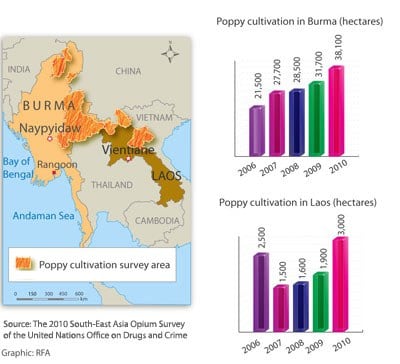Poppy cultivation in Burma, Laos, and Thailand has shot up for the fourth consecutive year, threatening to roll back steps taken to stem the drug trade in Southeast Asia's notorious Golden Triangle area.
Overall, cultivation in the region has almost doubled since 2006, according to the latest U.N. assessment of the opium trade in Southeast Asia.
It warns that the increase had the potential to push up regional opium production in 2010 by a whopping 75 percent from last year, with military-ruled Burma expected to grab the lion's share.
Most of the poppy cultivation in Southeast Asia occurs in the Golden Triangle, a relatively lawless territory straddling the borders of Burma, Laos, and Thailand, fueled by ethnic armies, opium warlords, and drug cartels.
The Southeast Asia Opium Survey Survey by the United Nations Office on Drugs and Crime (UNODC) shows a "relentlessly upward" year-on-year increase in poppy cultivation from the low point in 2006.
While poppy cultivation in the region remained well below the peak figures of the mid-1990s, the trend is seen by the U.N. as disturbing. It is being driven by "poverty and instability" which push farmers to grow, or sometimes return to growing, illicit crops.
"The recent global economic crisis appears to have exacerbated the situation for poor communities that cultivate opium poppy," said Yuri Fedotov, UNODC's executive director, referring to the global economic slump sparked by a financial crisis in the United States that peaked in 2008.
Rising opium prices
Another factor driving cultivation is the steeply rising price of opium over the last few years, he said.

The potential value for opium production in Southeast Asia rose dramatically to U.S.$219 million this year— an increase of U.S. $100 million over the 2009 estimate, and a monetary jump of 82 percent, the report said.
To reverse this "worrying trend," Fedotov asked countries in the region and their mostly Western donor partners to "urgently promote an integrated response" to improving basic security, including food security, in "these remote and often desperate communities."
Based on the U.N. poppy growing figures, Burma, Laos, and Thailand had a total area of 41,389 hectares (102,275 acres) under the crop in 2010.
Burma posted the biggest increase in actual area, with cultivation shooting up by 6,400 hectares (15,815 acres), or 20 per cent, to 38,100 hectares (nearly 98,150 acres) in 2010.
Laos experienced the largest increase in percentage terms (58 per cent), from 1,900 hectares (nearly 4,700 acres) to 3,000 hectares (7,410 acres).
Thailand's cultivation increased marginally from 211 hectares (520 acres) to 289 hectares (710 acres).
"As a result of the overall larger areas cultivated with poppy in all three countries and higher yields in Burma, the production levels in Burma shot up the most significantly," the report said.
Reported by Parameswaran Ponnudurai.
